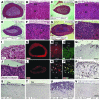MCM4 mutation causes adrenal failure, short stature, and natural killer cell deficiency in humans
- PMID: 22354170
- PMCID: PMC3287227
- DOI: 10.1172/JCI60224
MCM4 mutation causes adrenal failure, short stature, and natural killer cell deficiency in humans
Abstract
An interesting variant of familial glucocorticoid deficiency (FGD), an autosomal recessive form of adrenal failure, exists in a genetically isolated Irish population. In addition to hypocortisolemia, affected children show signs of growth failure, increased chromosomal breakage, and NK cell deficiency. Targeted exome sequencing in 8 patients identified a variant (c.71-1insG) in minichromosome maintenance-deficient 4 (MCM4) that was predicted to result in a severely truncated protein (p.Pro24ArgfsX4). Western blotting of patient samples revealed that the major 96-kDa isoform present in unaffected human controls was absent, while the presence of the minor 85-kDa isoform was preserved. Interestingly, histological studies with Mcm4-depleted mice showed grossly abnormal adrenal morphology that was characterized by non-steroidogenic GATA4- and Gli1-positive cells within the steroidogenic cortex, which reduced the number of steroidogenic cells in the zona fasciculata of the adrenal cortex. Since MCM4 is one part of a MCM2-7 complex recently confirmed as the replicative helicase essential for normal DNA replication and genome stability in all eukaryotes, it is possible that our patients may have an increased risk of neoplastic change. In summary, we have identified what we believe to be the first human mutation in MCM4 and have shown that it is associated with adrenal insufficiency, short stature, and NK cell deficiency.
Figures



Comment in
-
Unraveling human natural killer cell deficiency.J Clin Invest. 2012 Mar;122(3):798-801. doi: 10.1172/JCI62620. Epub 2012 Feb 22. J Clin Invest. 2012. PMID: 22354165 Free PMC article.
References
-
- Shepard TH, Landing BH, Mason DG. Familial Addison’s disease; case reports of two sisters with corticoid deficiency unassociated with hypoaldosteronism. AMA J Dis Child. 1959;97(2):154–162. - PubMed
-
- Musahl C, Schulte D, Burkhart R, Knippers R. A human homologue of the yeast replication protein Cdc21. Interactions with other Mcm proteins. Eur J Biochem. 1995;230(3):1096–1101. - PubMed
Publication types
MeSH terms
Substances
Grants and funding
LinkOut - more resources
Full Text Sources
Other Literature Sources
Medical
Molecular Biology Databases
Miscellaneous

